Abstract
Brain stem auditory-evoked response (BAER) is a noninvasive technique used for detecting neurophysiological abnormalities of the brain stem along the auditory pathway. Brain stem auditory-evoked response recordings were obtained from subcutaneous skin electrodes from two control sheep and 22 other sheep fed high sulfur (S) diets with low or high concentration of thiamine (B1), copper (Cu), and molybdenum (Mo). At least four peaks (I,II,III,IV) of varied amplitude were observed in all animals. Neurophysiological abnormalities due to decreased conductivity and/or excitability of nerve fibers along the auditory pathway were found on the BAER recordings of sheep fed high S diet. Abnormalities of peaks and interpeak latencies within BAER recordings were related to histopathological observations of brain stem lesions. Lesions in the areas of the cochlear nuclei and lateral lemniscus were seen in conjunction with altered BAER components. However, abnormalities in BAER recordings and lesions in the brain stem also occurred in the absence of overt clinical signs. Analysis of interpeak latencies between peaks I and IV revealed significant differences among dietary groups. Sheep given diets low in Cu, Mo, and B1 were affected most. Factorial analysis indicated B1 and interactions among Cu, Mo, and B1 as significant factors influencing interpeak latencies.
Full text
PDF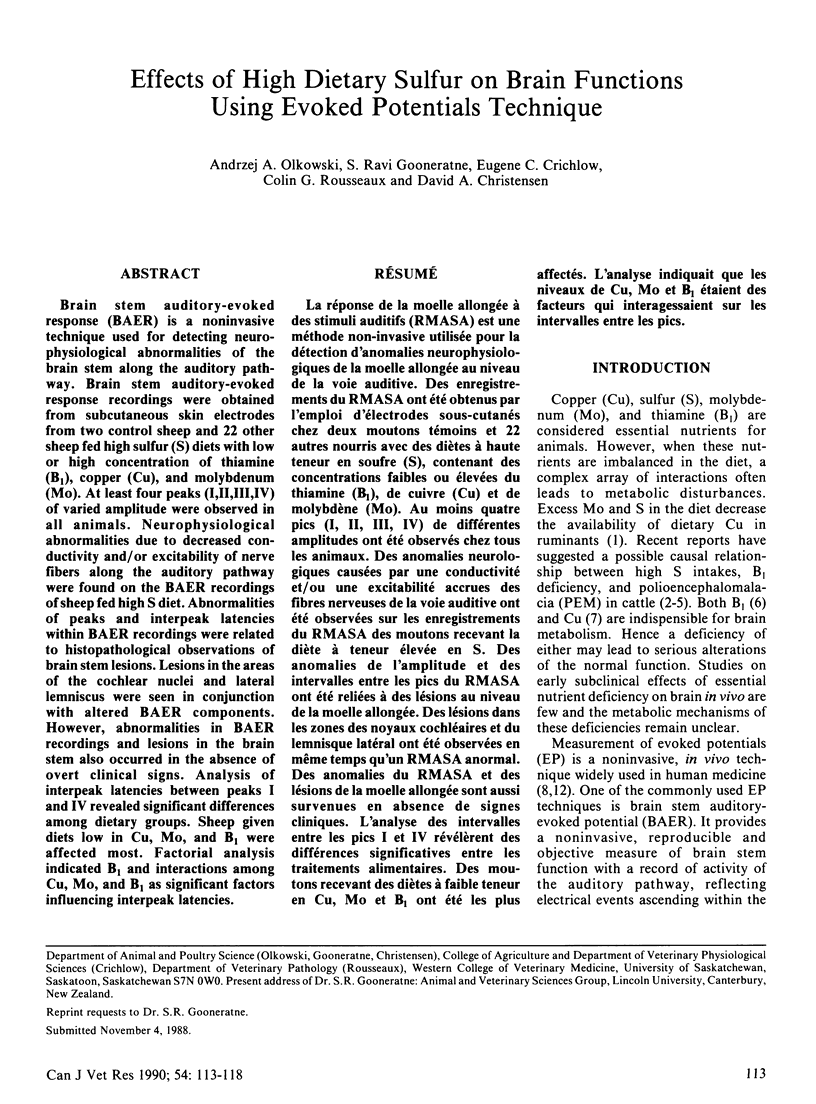
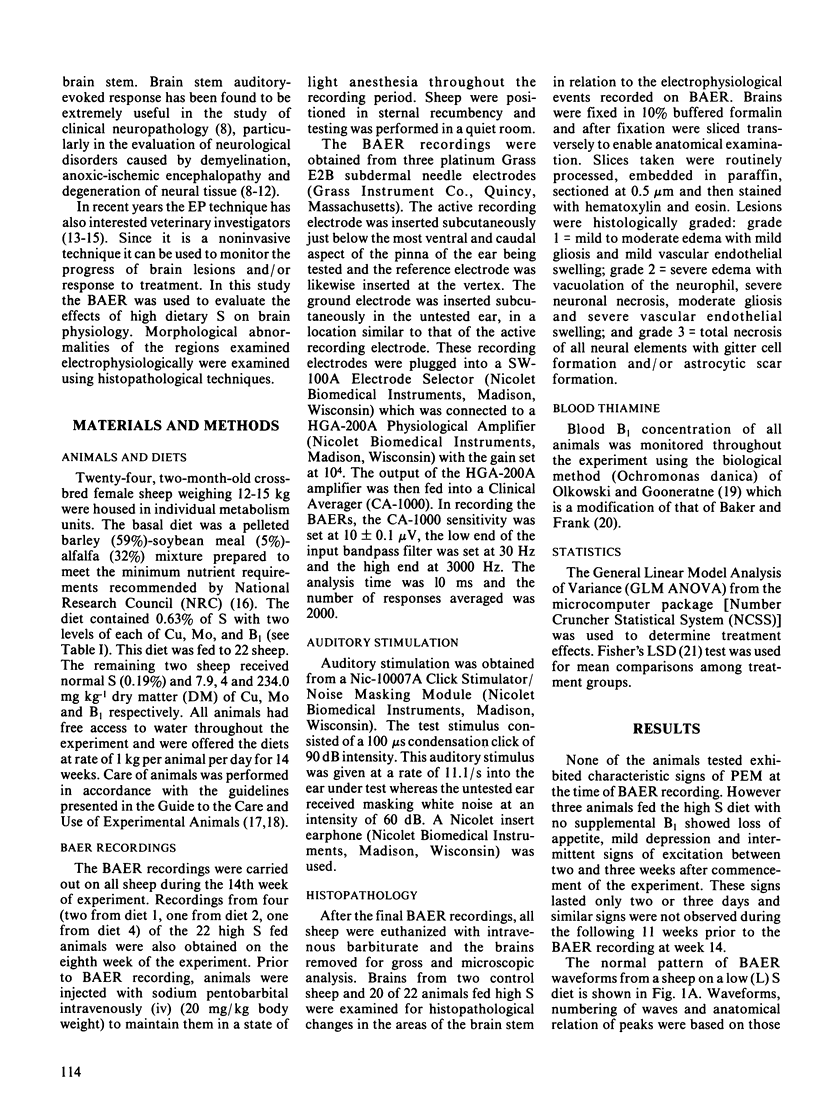
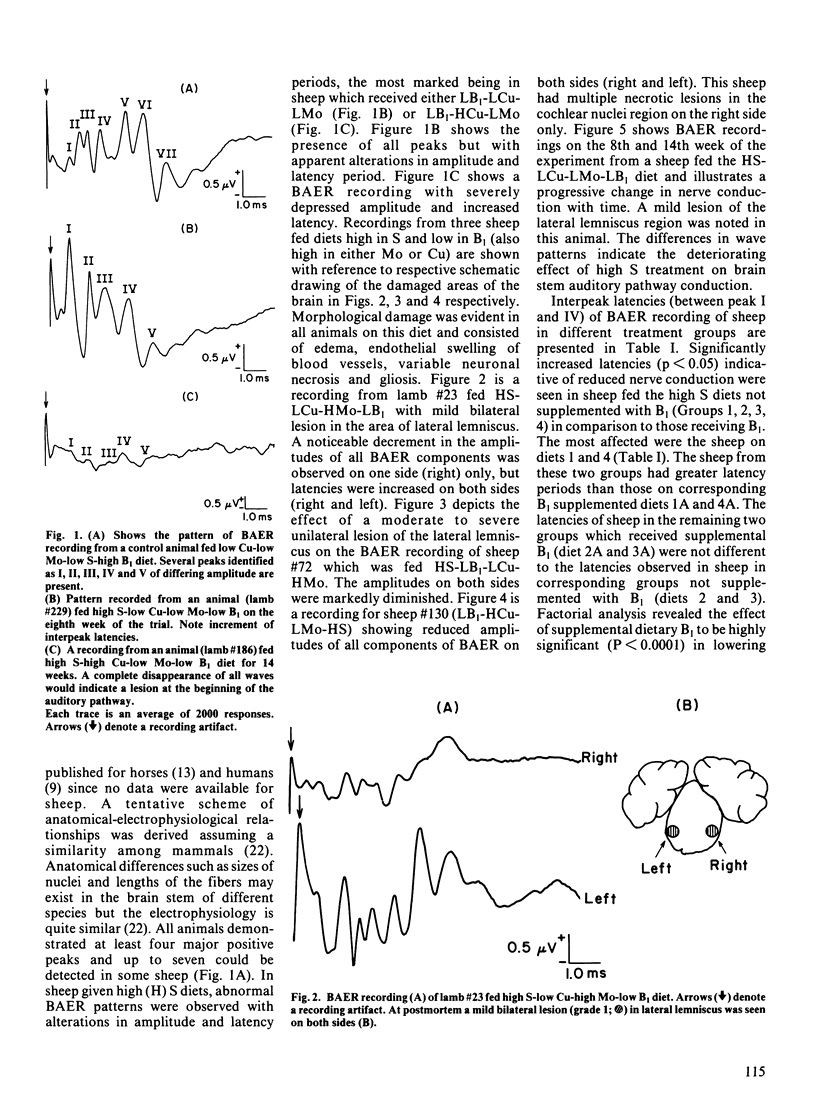
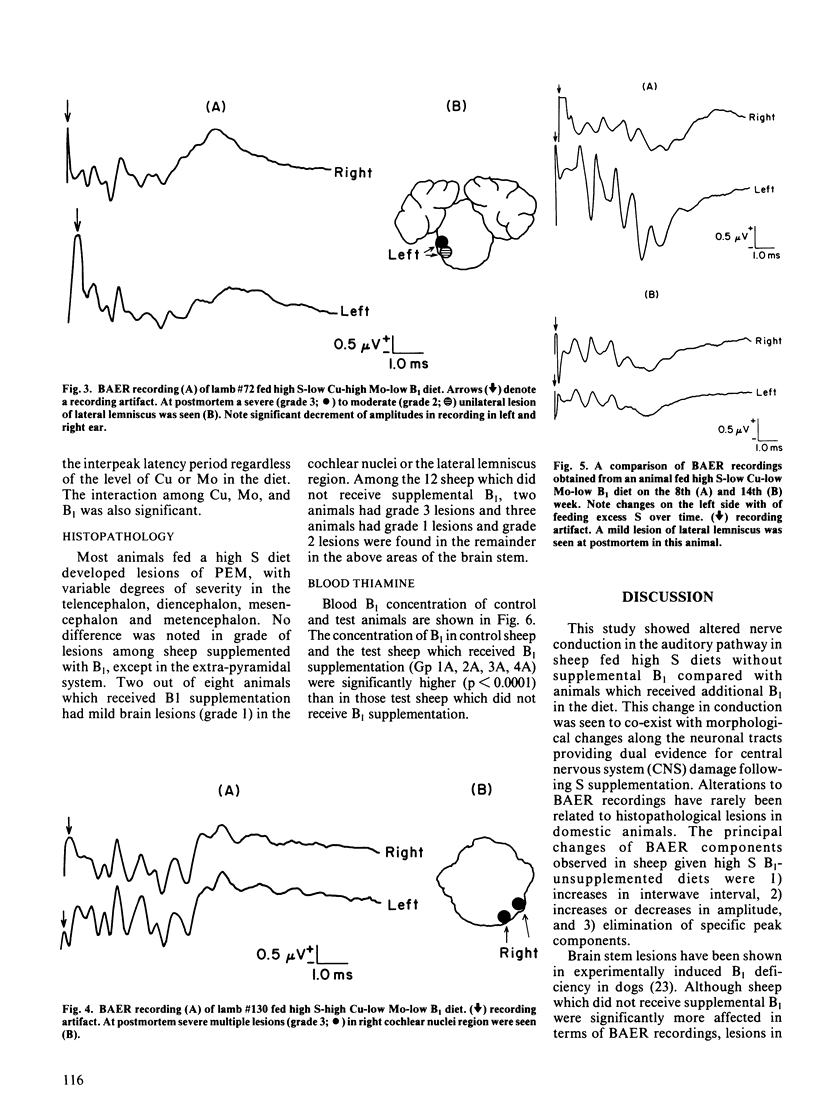

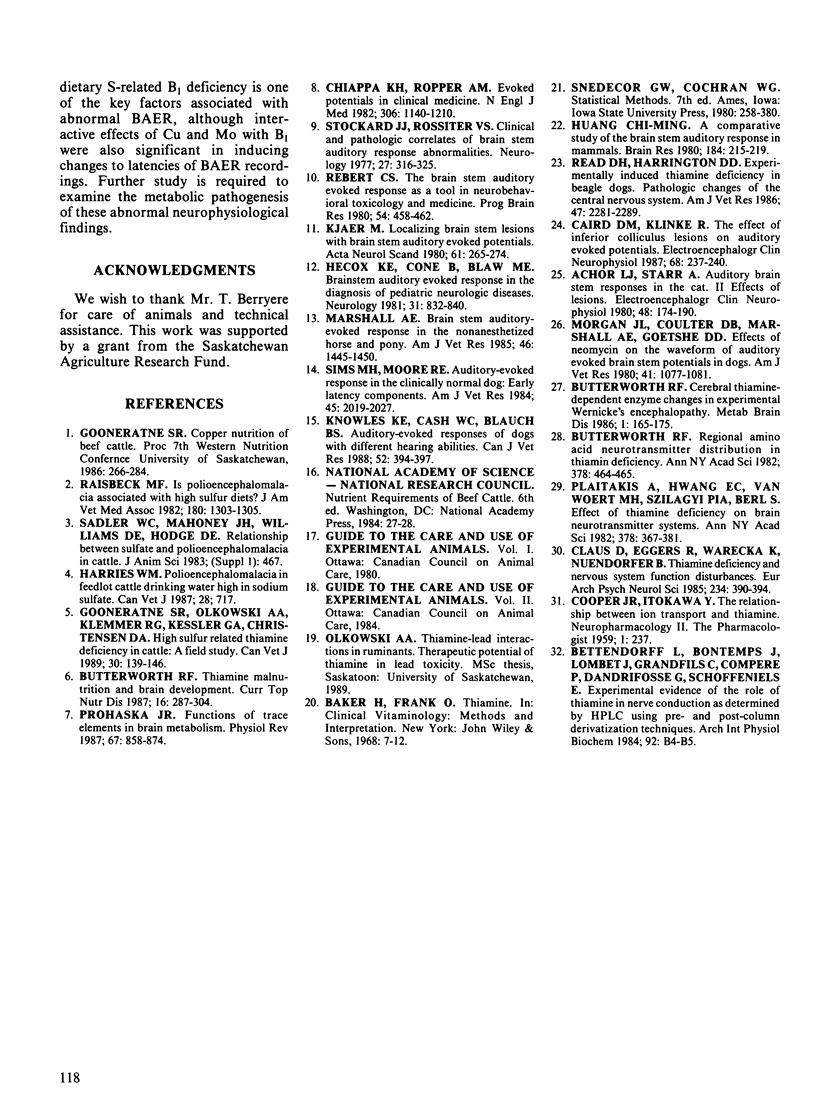
Selected References
These references are in PubMed. This may not be the complete list of references from this article.
- Achor L. J., Starr A. Auditory brain stem responses in the cat. II. Effects of lesions. Electroencephalogr Clin Neurophysiol. 1980 Feb;48(2):174–190. doi: 10.1016/0013-4694(80)90302-8. [DOI] [PubMed] [Google Scholar]
- Butterworth R. F. Cerebral thiamine-dependent enzyme changes in experimental Wernicke's encephalopathy. Metab Brain Dis. 1986 Sep;1(3):165–175. doi: 10.1007/BF01001778. [DOI] [PubMed] [Google Scholar]
- Caird D. M., Klinke R. The effect of inferior colliculus lesions on auditory evoked potentials. Electroencephalogr Clin Neurophysiol. 1987 May;68(3):237–240. doi: 10.1016/0168-5597(87)90034-7. [DOI] [PubMed] [Google Scholar]
- Chiappa K. H., Ropper A. H. Evoked potentials in clinical medicine (first of two parts). N Engl J Med. 1982 May 13;306(19):1140–1150. doi: 10.1056/NEJM198205133061904. [DOI] [PubMed] [Google Scholar]
- Claus D., Eggers R., Warecka K., Neundörfer B. Thiamine deficiency and nervous system function disturbances. Eur Arch Psychiatry Neurol Sci. 1985;234(6):390–394. doi: 10.1007/BF00386056. [DOI] [PubMed] [Google Scholar]
- Cross-Canada disease report. Can Vet J. 1987 Nov;28(11):717–717. [PMC free article] [PubMed] [Google Scholar]
- Gooneratne S. R., Olkowski A. A., Klemmer R. G., Kessler G. A., Christensen D. A. High sulfur related thiamine deficiency in cattle: A field study. Can Vet J. 1989 Feb;30(2):139–146. [PMC free article] [PubMed] [Google Scholar]
- Hecox K. E., Cone B., Blaw M. E. Brainstem auditory evoked response in the diagnosis of pediatric neurologic diseases. Neurology. 1981 Jul;31(7):832–840. doi: 10.1212/wnl.31.7.832. [DOI] [PubMed] [Google Scholar]
- Huang C. M. A comparative study of the brain stem auditory response in mammals. Brain Res. 1980 Feb 17;184(1):215–219. doi: 10.1016/0006-8993(80)90601-0. [DOI] [PubMed] [Google Scholar]
- Kjaer M. Localizing brain stem lesions with brain stem auditory evoked potentials. Acta Neurol Scand. 1980 May;61(5):265–274. doi: 10.1111/j.1600-0404.1980.tb01493.x. [DOI] [PubMed] [Google Scholar]
- Knowles K. E., Cash W. C., Blauch B. S. Auditory-evoked responses of dogs with different hearing abilities. Can J Vet Res. 1988 Jul;52(3):394–397. [PMC free article] [PubMed] [Google Scholar]
- Marshall A. E. Brain stem auditory-evoked response in the nonanesthetized horse and pony. Am J Vet Res. 1985 Jul;46(7):1445–1450. [PubMed] [Google Scholar]
- Morgan J. L., Coulter D. B., Marshall A. E., Goetsch D. D. Effects of neomycin on the waveform of auditory-evoked brain stem potentials in dogs. Am J Vet Res. 1980 Jul;41(7):1077–1081. [PubMed] [Google Scholar]
- Plaitakis A., Hwang E. C., Woert M. H., Szilagyi P. E., Berl S. Effect of thiamin deficiency on brain neurotransmitter systems. Ann N Y Acad Sci. 1982;378:367–381. doi: 10.1111/j.1749-6632.1982.tb31212.x. [DOI] [PubMed] [Google Scholar]
- Prohaska J. R. Functions of trace elements in brain metabolism. Physiol Rev. 1987 Jul;67(3):858–901. doi: 10.1152/physrev.1987.67.3.858. [DOI] [PubMed] [Google Scholar]
- Raisbeck M. F. Is polioencephalomalacia associated with high-sulfate diets? J Am Vet Med Assoc. 1982 Jun 1;180(11):1303–1305. [PubMed] [Google Scholar]
- Read D. H., Harrington D. D. Experimentally induced thiamine deficiency in beagle dogs: pathologic changes of the central nervous system. Am J Vet Res. 1986 Oct;47(10):2281–2289. [PubMed] [Google Scholar]
- Rebert C. S. The brain stem auditory evoked response as a tool in neuro-behavioral toxicology and medicine. Prog Brain Res. 1980;54:458–462. doi: 10.1016/S0079-6123(08)61661-1. [DOI] [PubMed] [Google Scholar]
- Sims M. H., Moore R. E. Auditory-evoked response in the clinically normal dog: early latency components. Am J Vet Res. 1984 Oct;45(10):2019–2027. [PubMed] [Google Scholar]
- Stockard J. J., Rossiter V. S. Clinical and pathologic correlates of brain stem auditory response abnormalities. Neurology. 1977 Apr;27(4):316–325. doi: 10.1212/wnl.27.4.316. [DOI] [PubMed] [Google Scholar]


